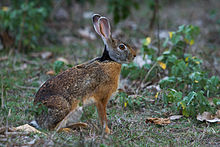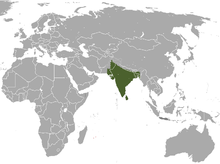J u m p t o c o n t e n t
M a i n m e n u
M a i n m e n u
N a v i g a t i o n
● M a i n p a g e ● C o n t e n t s ● C u r r e n t e v e n t s ● R a n d o m a r t i c l e ● A b o u t W i k i p e d i a ● C o n t a c t u s ● D o n a t e
C o n t r i b u t e
● H e l p ● L e a r n t o e d i t ● C o m m u n i t y p o r t a l ● R e c e n t c h a n g e s ● U p l o a d f i l e
S e a r c h
Search
● C r e a t e a c c o u n t ● L o g i n
P e r s o n a l t o o l s
● C r e a t e a c c o u n t ● L o g i n
P a g e s f o r l o g g e d o u t e d i t o r s l e a r n m o r e ● C o n t r i b u t i o n s ● T a l k
( T o p )
1 D e s c r i p t i o n
2 I n t r o d u c t i o n s
3 T a x o n o m y
4 R e f e r e n c e s
T o g g l e t h e t a b l e o f c o n t e n t s
I n d i a n h a r e
3 5 l a n g u a g e s
● ব া ং ল া ● Б ъ л г а р с к и ● B r e z h o n e g ● C a t a l à ● C e b u a n o ● D e u t s c h ● D i n é b i z a a d ● E s p a ñ o l ● E u s k a r a ● ف ا ر س ی ● F r y s k ● 한 국 어 ● B a h a s a I n d o n e s i a ● I t a l i a n o ● ע ב ר י ת ● K o t a v a ● К ы р ы к м а р ы ● മ ല യ ാ ള ം ● M a l t i ● م ص ر ى ● B a h a s a M e l a y u ● N e d e r l a n d s ● न े प ा ल ी ● O ʻ z b e k c h a / ў з б е к ч а ● P o r t u g u ê s ● R o m â n ă ● Р у с с к и й ● S u o m i ● S v e n s k a ● த ம ி ழ ் ● T ü r k ç e ● У к р а ї н с ь к а ● T i ế n g V i ệ t ● W i n a r a y ● 粵 語
E d i t l i n k s
● A r t i c l e ● T a l k
E n g l i s h
● R e a d ● E d i t ● V i e w h i s t o r y
T o o l s
T o o l s
A c t i o n s
● R e a d ● E d i t ● V i e w h i s t o r y
G e n e r a l
● W h a t l i n k s h e r e ● R e l a t e d c h a n g e s ● U p l o a d f i l e ● S p e c i a l p a g e s ● P e r m a n e n t l i n k ● P a g e i n f o r m a t i o n ● C i t e t h i s p a g e ● G e t s h o r t e n e d U R L ● D o w n l o a d Q R c o d e ● W i k i d a t a i t e m
P r i n t / e x p o r t
● D o w n l o a d a s P D F ● P r i n t a b l e v e r s i o n
I n o t h e r p r o j e c t s
● W i k i m e d i a C o m m o n s ● W i k i s p e c i e s
F r o m W i k i p e d i a , t h e f r e e e n c y c l o p e d i a
The Indian hare (Lepus nigricollis black-naped hare , is a common species of hare native to the Indian subcontinent ,[3] Java . Its habitat in Java is in rocky highlands.
Description [ edit ]
The weight of an adult Indian hare can reach 6 kg. Its body length can reach 40 cm. Its hair color is yellowish brown. Indian hares can live 5 to 10 years, and can become pregnant 7 times a year, with an average number of 6 to 12 cubs. Indian hares are relatively more immune to various diseases because they have adapted to a tropical climate, and they reproduce very quickly compared to imported rabbits. Indian hares are relatively small in size and don't have very thick fur.
Introductions [ edit ]
Indian hare in Rajkot
It has been introduced to Madagascar , Comoro Islands , Andaman Islands , Western New Guinea , Papua New Guinea , Seychelles , Mayotte , Mauritius and Réunion .[4]
Taxonomy [ edit ]
There are seven recognized subspecies of Indian hare.
Lepus nigricollis aryabertensis
Lepus nigricollis dayanus
Lepus nigricollis nigricollis
Lepus nigricollis ruficaudatus
Lepus nigricollis sadiya
Lepus nigricollis simcoxi
Lepus nigricollis singhala
References [ edit ]
^ Suchentrunk, F & Mihajla Davidovic (2004). "Evaluation of the classification of Indian hares (Lepus nigricollis ) into the genus Indolagus Gureev, 1953 (Leporidae, Lagomorpha)" (PDF) . Mammalian Biology . 69 1 ): 46–57. doi :10.1078/1616-5047-115 . Archived from the original (PDF) on 2016-03-03. Retrieved 2006-06-12 .
^ Long, J.L. (2003). Introduced Mammals of the World: Their History, Distribution and Influence . Cambridge: Cabi Publishing. doi :10.1071/9780643090156 . ISBN 9780851997483
R e t r i e v e d f r o m " https://en.wikipedia.org/w/index.php?title=Indian_hare&oldid=1212381477 " C a t e g o r i e s : ● I U C N R e d L i s t l e a s t c o n c e r n s p e c i e s ● L e p u s ● M a m m a l s o f S o u t h A s i a ● M a m m a l s o f I n d i a ● M a m m a l s d e s c r i b e d i n 1 8 2 3 ● T a x a n a m e d b y F r é d é r i c C u v i e r H i d d e n c a t e g o r i e s : ● A r t i c l e s w i t h s h o r t d e s c r i p t i o n ● S h o r t d e s c r i p t i o n m a t c h e s W i k i d a t a ● A r t i c l e s w i t h ' s p e c i e s ' m i c r o f o r m a t s
● T h i s p a g e w a s l a s t e d i t e d o n 7 M a r c h 2 0 2 4 , a t 1 5 : 3 0 ( U T C ) . ● T e x t i s a v a i l a b l e u n d e r t h e C r e a t i v e C o m m o n s A t t r i b u t i o n - S h a r e A l i k e L i c e n s e 4 . 0 ;
a d d i t i o n a l t e r m s m a y a p p l y . B y u s i n g t h i s s i t e , y o u a g r e e t o t h e T e r m s o f U s e a n d P r i v a c y P o l i c y . W i k i p e d i a ® i s a r e g i s t e r e d t r a d e m a r k o f t h e W i k i m e d i a F o u n d a t i o n , I n c . , a n o n - p r o f i t o r g a n i z a t i o n . ● P r i v a c y p o l i c y ● A b o u t W i k i p e d i a ● D i s c l a i m e r s ● C o n t a c t W i k i p e d i a ● C o d e o f C o n d u c t ● D e v e l o p e r s ● S t a t i s t i c s ● C o o k i e s t a t e m e n t ● M o b i l e v i e w ●
T o g g l e l i m i t e d c o n t e n t w i d t h




